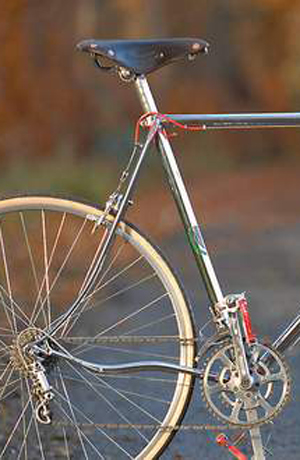Mike Moulton: Restored
 Fri, January 25, 2013
Fri, January 25, 2013

Somewhere back around the end of 2005 I received an email from a Joe Cerone:
Sir: I have a bike that was custom made for me by a Lockheed Engineer by the name of Mike Moulton, his name is stamped on the fork.
He made this for me in 1949 and I raced it all over America as well as a member of the All American Team that toured Japan in 1951.
I won three California State Championships on the bike, 49,50, 51. Are you any kin to Mike?----Joe Cirone.
This was the first I had heard of Mike Moulton. We are not related but Moulton is a quite common English name. I later wrote an article here, and as a result I was contacted by Mike Moulton’s daughter and his nephew, unfortunately after I responded they never got back to me.

As Joe stated, Mike Moulton was an engineer at Lockheed Aircraft and started building frames as a hobby around 1947.
He built frames for about 4 years or so. The bike on the left is the one he built for Joe Cerone.
Los Angeles area cyclists raced on his bikes all around especially in those early years when the Burbank track was up and running around 1948/9.
Just this week I received an email from Jeff Groman who sent me pictures of a beautifully restored bike built by Mike Moulton in the mid to late 1940s. It was originally built for a rider named “Rusty” Baker.

The bike is built up with period correct parts including Airlite hubs, Chater Lea cranks, the handlebar stem is of unknown make. The bike will be displayed at Classic Cycles, Bainbridge Island, WA.



Although Mike Moulton only built a few frames as a hobby, he did so in an era when there were very few other American framebuilders. So this is a wonderful thing that Jeff Groman has done by restoring this bike. It is an important piece of Americana and American bike history.
Mike would have had to get his materials mailed over from England. The lugs are Chater Lea cast steel. These were rough sand casting that required a great deal of hand filing, and were typical of those used by English builders in the 1930s and 1940s. The tubing is most likely Reynolds 531.
Below are pictures of the bike before restoration.
 Dave Moulton | Comments Off |
Dave Moulton | Comments Off | 
































